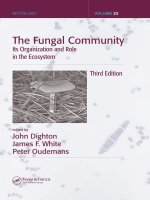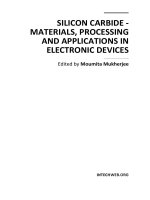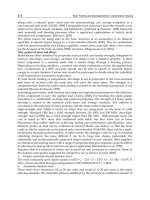The Fungal Community Its Organization and Role in the Ecosystem Third Edition docx
Bạn đang xem bản rút gọn của tài liệu. Xem và tải ngay bản đầy đủ của tài liệu tại đây (14.32 MB, 966 trang )
The Fungal
Community
Its Organization and Role
in the Ecosystem
Third Edition
MYCOLOGY SERIES
Editor
J. W. Bennett
Professor
Department of Cell and Molecular Biology
Tulane University
New Orleans, Louisiana
Founding Editor
Paul A. Lemke
1.
Viruses and Plasmids in Fungi,
edited by Paul A. Lemke
2.
The Fungal Community: Its Organization and Role in the Ecosystem,
edited by Donald
T. Wicklow and George C. Carroll
3.
Fungi Pathogenic for Humans and Animals (in three parts),
edited by Dexter H. Howard
4.
Fungal Differentiation: A Contemporary Synthesis,
edited by John E. Smith
5.
Secondary Metabolism and Differentiation in Fungi,
edited by Joan W. Bennett and
Alex Ciegler
6.
Fungal Protoplasts,
edited by John F. Peberdy and Lajos Ferenczy
7.
Viruses of Fungi and Simple Eukaryotes,
edited by Yigal Koltin and Michael J. Leibowitz
8.
Molecular Industrial Mycology: Systems and Applications for Filamentous Fungi,
edited by Sally A. Leong and Randy M. Berka
9.
The Fungal Community: Its Organization and Role in the Ecosystem, Second Edition,
edited by George C. Carroll and Donald T. Wicklow
10.
Stress Tolerance of Fungi,
edited by D. H. Jennings
11.
Metal Ions in Fungi,
edited by Gü'fcnther Winkelmann and Dennis R. Winge
12.
Anaerobic Fungi: Biology, Ecology, and Function,
edited by Douglas O. Mountfort and
Colin G. Orpin
13.
Fungal Genetics: Principles and Practice,
edited by Cees J. Bos
14.
Fungal Pathogenesis: Principles and Clinical Applications,
edited by Richard A.
Calderone and Ronald L. Cihlar
15.
Molecular Biology of Fungal Development,
edited by Heinz D. Osiewacz
16.
Pathogenic Fungi in Humans and Animals: Second Edition,
edited by Dexter H. Howard
17.
Fungi in Ecosystem Processes,
John Dighton
18.
Genomics of Plants and Fungi,
edited by Rolf A. Prade and Hans J. Bohnert
19.
Clavicipitalean Fungi: Evolutionary Biology, Chemistry, Biocontrol, and Cultural Impacts,
edited by James F. White Jr., Charles W. Bacon, Nigel L. Hywel-Jones, and Joseph W.
Spatafora
20.
Handbook of Fungal Biotechnology, Second Edition,
edited by Dilip K. Arora
21.
Fungal Biotechnology in Agricultural, Food, and Environmental Applications,
edited
by Dilip K. Arora
22.
Handbook of Industrial Mycology,
edited by Zhiqiang An
23.
The Fungal Community: Its Organization and Role in the Ecosystem, Third Edition,
edited by John Dighton, James F. White, and Peter Oudemans
The Fungal
Community
Its Organization and Role
in the Ecosystem
Third Edition
edited by
John Dighton
James F. White
Peter Oudemans
Published in 2005 by
CRC Press
Taylor & Francis Group
6000 Broken Sound Parkway NW, Suite 300
Boca Raton, FL 33487-2742
© 2005 by Taylor & Francis Group, LLC
CRC Press is an imprint of Taylor & Francis Group
No claim to original U.S. Government works
Printed in the United States of America on acid-free paper
10987654321
International Standard Book Number-10: 0-8247-2355-4 (Hardcover)
International Standard Book Number-13: 978-0-8247-2355-2 (Hardcover)
This book contains information obtained from authentic and highly regarded sources. Reprinted material is quoted with
permission, and sources are indicated. A wide variety of references are listed. Reasonable efforts have been made to publish
reliable data and information, but the author and the publisher cannot assume responsibility for the validity of all materials
or for the consequences of their use.
No part of this book may be reprinted, reproduced, transmitted, or utilized in any form by any electronic, mechanical, or
other means, now known or hereafter invented, including photocopying, microfilming, and recording, or in any information
storage or retrieval system, without written permission from the publishers.
For permission to photocopy or use material electronically from this work, please access www.copyright.com
( or contact the Copyright Clearance Center, Inc. (CCC) 222 Rosewood Drive, Danvers, MA
01923, 978-750-8400. CCC is a not-for-profit organization that provides licenses and registration for a variety of users. For
organizations that have been granted a photocopy license by the CCC, a separate system of payment has been arranged.
Trademark Notice:
Product or corporate names may be trademarks or registered trademarks, and are used only for
identification and explanation without intent to infringe.
Library of Congress Cataloging-in-Publication Data
The Fungal community : its organization and role in the ecosystem / edited by John
Dighton, James F. White, Peter Oudemans. — 3rd ed.
p. cm. — (Mycology)
Includes bibliographical references and index.
ISBN 0-8247-2355-4 (alk. paper)
I. Dighton, J. (John) II. White, James F. (James Francis), 1953- III. Oudemans, Peter.
IV. Mycology series.
QK604.2.C64F86 2005
579.5'17—dc22 2004061821
Visit the Taylor & Francis Web site at
and the CRC Press Web site at
Taylor & Francis Group
is the Academic Division of T&F Informa plc.
DK3133_C000.fm Page iv Monday, April 18, 2005 1:41 PM
v
Preface
The third edition of
The Fungal Community
has been compiled by a new set of editors. The
three of us were impressed with the quality and content of the previous two editions and
hope that we have matched the work of George Carroll and Don Wicklow in this new volume.
The aims and objectives of this volume are explained in our introductory chapter,
but in brief, we have tried to address some of the current discussions in ecology (diversity
and function, scaling issues, disturbance, invasive species) from a fungal perspective. In
order to be able to address these issues, we need appropriate techniques to identify fungi,
determine their abundance, determine their associations among themselves and other organ-
isms, measure their individual and community function, and be able to scale these measures
from the microscopic level of the individual hyphal or fungal cell through local to landscape
and ecosystem levels. The chapters of this edition have advanced toward addressing these
aspects of mycology and beyond, but they are by no means all-encompassing. We apologize
if some areas are missing, but the size of this volume speaks for the complexity and
dimension of aspects relating to the functional role of fungal communities in ecosystems,
and this book would be overwhelmingly large if we included more. There is a huge body
of literature in both mycological and ecological journals that pertains to the themes con-
tained herein, and we praise our authors for their extensive bibliographies, which will steer
interested readers to some of the most recent publications in their specific areas.
DK3133_C000.fm Page v Monday, April 18, 2005 1:41 PM
DK3133_C000.fm Page vi Monday, April 18, 2005 1:41 PM
vii
Editors
John Dighton
is a professor in the Institute of Marine and Coastal Sciences (Cook College)
and Biology Department (Camden) and director of the Pinelands Field Station of Rutgers
University. He is the author of
Fungi in Ecosystem Processes
(2003) and author or coauthor
of over 100 journal articles on soil ecology and mycology. He is a member of the British
Mycological Society, the Mycological Society of America, and the Ecological Society of
America. John Dighton is on the editorial board of
Mycological Research, Soil Biology
and Biochemistry,
and
Bartonia
. He received his B.Sc. degree as an external student of
London University in botany and zoology, an M.Sc. degree in ecology from Durham
University, and a Ph.D. in ecology from London University.
James F. White, Jr.
, is a professor of plant biology and pathology at Cook College,
Rutgers University, New Brunswick, New Jersey. He is the editor or coeditor of several
books, including
The Clavicipitalean Fungi
(2004),
Microbial Endophytes
(2000), and
Biotechnology of Acremonium Endophytes of Grasses
(1994). He is the author or coauthor
of over 130 journal articles and book chapters, and 50 abstracts, posters, and invited
lectures. He is a member of the American Phytopathological Society, the Mycological
Society of America, and the American Society for Microbiology. Dr. White is an associate
editor of the mycological journal
Mycologia
and was a founding member and past secretary
of the International Symbiosis Society. Dr. White received a B.S. degree in botany and an
M.S. degree in mycology and plant pathology from Auburn University, Alabama, and a
Ph.D. degree in mycology and botany from the University of Texas, Austin.
Peter Oudemans
is an associate professor in the Department of Plant Biology and
Pathology at Rutgers University and is stationed at the Philip E. Marucci Center for
Blueberry and Cranberry Research and Extension. His research goals are aimed at the
biology and control of fungal diseases of the blueberry and cranberry. To accomplish these
goals, he uses remote sensing and geographic information system methodologies to detect,
map, quantify, and track plant pathogens, as well as other interacting factors that influence
crop quality and yield. In addition to research, he teaches classes in plant pathology and
mycology, as well as a colloquium course entitled “Agriculture in the Pinelands.” He
received his training at the University of New Brunswick (B.S.), the University of Guelph
(M.S.), and the University of California (Ph.D.), as well as postgraduate training at Duke
University and the University of Kansas.
DK3133_C000.fm Page vii Monday, April 18, 2005 1:41 PM
DK3133_C000.fm Page viii Monday, April 18, 2005 1:41 PM
ix
Acknowledgments
We thank
all our authors for their contributions and for helping to make the process of
editing this volume as painless as possible. We hope that we have not put too much pressure
on any of them. We also extend a debt of gratitude to Magnus Anusiem, Vanessa McCowan,
and other members of our laboratories who have helped us with collating and indexing
this book.
DK3133_C000.fm Page ix Monday, April 18, 2005 1:41 PM
DK3133_C000.fm Page x Monday, April 18, 2005 1:41 PM
xi
Contributors
Ann E. Arnold
Department of Biology
Duke University
Durham, North Carolina, USA
Charles W. Bacon
Toxicology and Mycotoxin Research
Unit
Russell Research Center
Athens, Georgia, USA
Felix Bärlocher
Mount Allison University
Sackville, New Brunswick, Canada
James W. Baxter
Department of Biological Sciences
Sacramento State University
Sacramento, California, USA
Jayne Belnap
U.S. Geological Survey
Moab, Utah, USA
James D. Bever
Department of Biology
Indiana University
Bloomington, Indiana, USA
Martin I. Bidartondo
Imperial College London
and
Royal Botanic Gardens
Kew, UK
Joseph F. Bischoff
National Center for Biotechnology
Information
National Institutes of Health
Bethesda, Maryland, USA
Euan P. Burford
Division of Environmental and Applied
Biology
Biological Sciences Institute
School of Life Sciences
University of Dundee
Dundee, Scotland, UK
Lei Cai
Centre for Research in Fungal Diversity
Department of Ecology and Biodiversity
The University of Hong Kong
Hong Kong
John W.G. Cairney
Centre for Horticulture and Plant Sciences
University of Western Sydney
New South Wales, Australia
DK3133_C000.fm Page xi Monday, April 18, 2005 1:41 PM
xii
Andrew W. Claridge
Department of Conservation and
Environment
Parks and Wildlife Division
Queanbeyan, New South Wales, Australia
Keith Clay
Department of Biology
Indiana University
Bloomington, Indiana, USA
Kirk J. Czymmek
Department of Biological Sciences
University of Delaware
Newark, Delaware, USA
John Dighton
Rutgers University Pinelands Field
Station
New Lisbon, New Jersey, USA
Daniel M. Durall
Biology Department
Okanagan University College
Kelowna, British Columbia, Canada
Louise M. Egerton-Warburton
Chicago Botanic Garden
Glencoe, Illinois, USA
Nataliya Ellanska
M.M. Grisko National Botanical Garden
NAN Ukraine
Kiev, Ukraine
Roger D. Finlay
Department of Forest Mycology and
Pathology
Swedish University of Agricultural
Sciences
Uppsala, Sweden
Marina Fomina
Division of Environmental and Applied
Biology
Biological Sciences Institute
School of Life Sciences
University of Dundee
Dundee, Scotland, UK
Geoffrey M. Gadd
Division of Environmental and Applied
Biology
Biological Sciences Institute
School of Life Sciences
University of Dundee
Dundee, Scotland, UK
Monique Gardes
Laboratoire Evolution et Diversité
Biologique
Université Paul Sabatier
Toulouse, France
Erast Golovko
M.M. Grisko National Botanical Garden
NAN Ukraine
Kiev, Ukraine
Everett M. Hansen
Department of Botany and Plant Pathology
Oregon State University
Corvallis, Oregon, USA
Kurt Haselwandter
Department of Microbiology
University of Innsbruck
Innsbruck, Austria
David L. Hawksworth
MycoNova
The Yellow House
Mataelpino
Madrid, Spain
Joan M. Henson
Department of Microbiology
Montana State University
Bozeman, Montana, USA
Edward A. Herre
Smithsonian Tropical Research Institute
Balboa, Republic of Panama
Bradley I. Hillman
Department of Plant Biology and
Pathology
Rutgers University
New Brunswick, New Jersey, USA
DK3133_C000.fm Page xii Monday, April 18, 2005 1:41 PM
xiii
Erik A. Hobbie
Complex Systems Research Center
University of New Hampshire
Durham, New Hampshire, USA
Kevin D. Hyde
Centre for Research in Fungal Diversity
Department of Ecology and Biodiversity
The University of Hong Kong
Hong Kong
Rajesh Jeewon
Centre for Research in Fungal Diversity
Department of Ecology and Biodiversity
The University of Hong Kong
Hong Kong
Melanie D. Jones
Biology Department
Okanagan University College
Kelowna, British Columbia, Canada
Ari Jumpponen
Division of Biology
Kansas State University
Manhattan, Kansas, USA
Tamar Kis-Papo
Institute of Evolution
The University of Haifa
Mount Carmel, Israel
Donald Y. Kobayashi
Department of Plant Biology and
Pathology
Rutgers University
New Brunswick, New Jersey, USA
Ingrid Kottke
Eberhard-Karls University Tuebingen
Botanical Institute
Systematic Botany
Mycology and Botanical Garden
Tuebingen, Germany
Damond A.
Kyllo
Smithsonian Tropical Research Institute
Ancon, Republic of Panama
Otto L. Lange
Julius-von-Sachs Institute für
Biowissenschaften
University of Würzburg
Würzburg, Germany
Adrian Leuchtmann
Geobotanisches Institut ETH
Zurich, Switzerland
Kathy J. Lewis
Department of Forestry
University of Northern British Columbia
Prince George, British Columbia, Canada
Erik Lilleskov
USDA Forest Service
Forestry Sciences Laboratory
Houghton, Michigan, USA
Björn D. Lindahl
Department of Forest Mycology and
Pathology
Swedish University of Agricultural
Sciences
Uppsala, Sweden
D. Jean Lodge
Center for Forest Mycology Research
USDA Forest Service
Forest Products Laboratory
Luquillo, Puerto Rico
John Lussenhop
Biological Sciences Department
University of Illinois at Chicago
Chicago, Illinois, USA
Philip Lyons
Department of Natural Sciences
University of Houston–Downtown
Houston, Texas, USA
Zuleyka Maynard
Smithsonian Tropical Research Institute
Balboa, Republic of Panama
DK3133_C000.fm Page xiii Monday, April 18, 2005 1:41 PM
xiv
Bruce A. McDonald
Institute of Plant Sciences
Phytopathology Group
ETH Zentrum/LFW
Zürich, Switzerland
Luis C. Mejia
Smithsonian Tropical Research Institute
Balboa, Republic of Panama
Julian I. Mitchell
School of Biological Sciences
University of Portsmouth
Portsmouth, UK
Sherri J. Morris
Biology Department
Bradley University
Peoria, Illinois, USA
Gregory M. Mueller
Department of Botany
Field Museum of Natural History
Chicago, Illinois, USA
Peter Oudemans
Philip Maricci Center for Blueberry and
Cranberry Research
Rutgers University
Chatsworth, New Jersey, USA
Jean-François Ponge
Museum National d’Histoire Naturelle
Brunoy, France
Regina S. Redman
Department of Biology
University of Washington
Seattle, Washington, USA
David M. Rizzo
Department of Plant Pathology
University of California
Davis, California, USA
Nancy Robbins
Department of Plant Biology
Rutgers University
New Brunswick, New Jersey, USA
G. Philip Robertson
Department of Crop and Soil Sciences
Michigan State University, Lansing
and
W.K. Kellogg Biological Station
Michigan State University
Hickory Corners, Michigan, USA
Russell J. Rodriguez
U.S. Geological Survey
WFRC
Seattle, Washington, USA
Enith Rojas
Smithsonian Tropical Research Institute
Balboa, Republic of Panama
Jennifer A. Rudgers
Department of Biology
Indiana University
Bloomington, Indiana, USA
Liliane Ruess
Institute of Zoology
Technical University of Darmstadt
Darmstadt, Germany
Christopher L. Schardl
Department of Plant Pathology
University of Kentucky
Lexington, Kentucky, USA
John Paul Schmit
Department of Plant Biology
University of Illinois at
Urbana–Champaign
Urbana, Illinois, USA
Peggy A. Schultz
Department of Biology
Indiana University
Bloomington, Indiana, USA
Robert L. Sinsabaugh
Biology Department
University of New Mexico
Albuquerque, New Mexico, USA
DK3133_C000.fm Page xiv Monday, April 18, 2005 1:41 PM
xv
Jeffrey K. Stone
Department of Botany and Plant Pathology
Oregon State University
Corvallis, Oregon, USA
Mary E. Stromberger
Department of Soil and Crop Sciences
Colorado State University
Fort Collins, Colorado, USA
Michael J. Swift
Tropical Soil Biology and Fertility Institute
of CIAT
Nairobi, Kenya
and
Institut de Recherche pour le
Developpement
Montpellier, France
James M. Trappe
Department of Forest Science
Oregon State University
Corvallis, Oregon, USA
Kathleen K. Treseder
Department of Ecology and Evolutionary
Biology and Department of Earth System
Science
University of California
Irvine, California, USA
Amy R. Tuininga
Department of Biological Sciences
Louis Calder Center
Fordham University
Armonk, New York, USA
Katarzyna Turnau
Institute of Botany of the Jagiellonian
University
Krakow, Poland
Sunshine A. Van Bael
Smithsonian Tropical Research Institute
Balboa, Republic of Panama
Milton Wainwright
Department of Molecular Biology and
Biotechnology
University of Sheffield
Sheffield, UK
Roy Watling
Caledonian Mycological Enterprises
and
Royal Botanic Garden
Edinburgh, Scotland, UK
James F. White, Jr.
Department of
Plant Biology and
Pathology
Cook College–Rutgers University
New Brunswick, New Jersey, USA
John Zak
Department of Biological Sciences
Texas Tech University
Lubbock, Texas, USA
Valentina A. Zakharchenko
Institute of Microbiology and Virology
National Academy of Sciences of the
Ukraine
Kiev, Ukraine
Jiasui Zhan
Scottish Crop Research Institute
Invergowrie
Dundee, Scotland, UK
Nelli N. Zhdanova
Institute of Microbiology and Virology
National Academy of Sciences of the
Ukraine
Kiev, Ukraine
Alga Zuccaro
Institute of Microbiology
Technical University of Braunschweig
Braunschweig, Germany
DK3133_C000.fm Page xv Monday, April 18, 2005 1:41 PM
DK3133_C000.fm Page xvi Monday, April 18, 2005 1:41 PM
xvii
Contents
Introduction 1
John Dighton, James F. White, Jr., and Peter Oudemans
SECTION 1 Structure of Fungal Communities
1
Linking Function between Scales of Resolution 13
Sherri J. Morris and G. Philip Robertson
2
Fungal Communities: Their Diversity and Distribution 27
David L. Hawksworth and Gregory M. Mueller
3
Freshwater Fungal Communities 39
Felix Bärlocher
4
Marine Fungal Communities 61
Tamar Kis-Papo
5
Tropical Fungi 93
Kevin D. Hyde, Lei Cai, and Rajesh Jeewon
6
Lichens and Microfungi in Biological Soil Crusts: Community Structure,
Physiology, and Ecological Functions 117
Jayne Belnap and Otto L. Lange
7
Mycorrhizal Fungi in Successional Environments: A Community Assembly
Model Incorporating Host Plant, Environmental, and Biotic Filters 139
Ari Jumpponen and Louise M. Egerton-Warburton
8
Fungal Communities: Relation to Resource Succession 169
Jean-François Ponge
DK3133_bookTOC.fm Page xvii Monday, April 18, 2005 11:33 AM
xviii
9
Emerging Perspectives on the Ecological Roles of Endophytic Fungi
in Tropical Plants 181
Sunshine A. Van Bael, Zuleyka Maynard, Enith Rojas, Luis C. Mejia,
Damond A. Kyllo, Edward A. Herre, Nancy Robbins, Joseph F. Bischoff,
and Ann E. Arnold
10
Classical Methods and Modern Analysis for Studying Fungal Diversity 193
John Paul Schmit and D. Jean Lodge
11
Fungal Diversity in Molecular Terms: Profiling, Identification, and
Quantification in the Environment 215
Martin I. Bidartondo and Monique Gardes
12
Analytical and Experimental Methods for Estimating Population Genetic
Structure of Fungi 241
Jiasui Zhan and Bruce A. McDonald
13
Interspecific Interaction Terminology: From Mycology to General Ecology 265
Amy R. Tuininga
SECTION 2 Function of Fungal Communities
14
Fungal Activity as Determined by Microscale Methods with Special
Emphasis on Interactions with Heavy Metals 287
Katarzyna Turnau and Ingrid Kottke
15
Exploring Fungal Activity with Confocal and Multiphoton Microscopy 307
Kirk J. Czymmek
16
Enzymatic Activities of Mycelia in Mycorrhizal Fungal Communities 331
Björn D. Lindahl, Roger D. Finlay, and John W.G. Cairney
17
Fungal Enzymes at the Community Scale 349
Robert L. Sinsabaugh
18
Using Isotopic Tracers to Follow Carbon and Nitrogen Cycling of Fungi 361
Erik A. Hobbie
19
Diversity-Functioning Relationships in Ectomycorrhizal Fungal
Communities 383
James W. Baxter and John Dighton
20
Fungi, Bacteria, and Viruses as Pathogens of the Fungal Community 399
Donald Y. Kobayashi and Bradley I. Hillman
21
Fungal Endophytes in Terrestrial Communities and Ecosystems 423
Jennifer A. Rudgers and Keith Clay
DK3133_bookTOC.fm Page xviii Monday, April 18, 2005 11:33 AM
xix
22
Mechanisms of Arbuscular Mycorrhizal Mediation of Plant–Plant
Interactions 443
James D. Bever and Peggy A. Schultz
23
Impacts of Plant Pathogenic Fungi on Plant Communities 461
Everett M. Hansen and Jeffrey K. Stone
24
The
Epichloë
Endophytes of Grasses and the Symbiotic Continuum 475
Christopher L. Schardl and Adrian Leuchtmann
25
Evolutionary Development of the Clavicipitaceae 505
Joseph F. Bischoff and James F. White, Jr.
26
Ecological Fitness Factors for Fungi within the Balansieae and Clavicipiteae 519
Charles W. Bacon and Philip Lyons
27
Fungal Communities of Seaweeds 533
Alga Zuccaro and Julian I. Mitchell
28
Trophic Interactions of Fungi and Animals 581
Liliane Ruess and John Lussenhop
29
Sporocarp Mycophagy: Nutritional, Behavioral, Evolutionary,
and Physiological Aspects 599
Andrew W. Claridge and James M. Trappe
30
Hypogeous Fungi: Evolution of Reproductive and Dispersal Strategies
through Interactions with Animals and Mycorrhizal Plants 613
James M. Trappe and Andrew W. Claridge
SECTION 3 Human Impacts on Fungal Communities and Their Function
31
Human Impacts on Biodiversity and Ecosystem Services: An Overview 627
Michael J. Swift
32
Oligotrophic Growth of Fungi 643
Milton Wainwright
33
Fungal Communities of Desert Ecosystems: Links to Climate Change 659
John Zak
34
Symbiotic Lifestyle Expression by Fungal Endophytes and the Adaptation
of Plants to Stress: Unraveling the Complexities of Intimacy 683
Russell J. Rodriguez, Regina S. Redman, and Joan M. Henson
35
Biological Soil Crusts and Global Changes: What Does the Future Hold? 697
Jayne Belnap and Otto L. Lange
DK3133_bookTOC.fm Page xix Monday, April 18, 2005 11:33 AM
xx
36
Nutrient Acquisition Strategies of Fungi and Their Relation to Elevated
Atmospheric CO
2
713
Kathleen K. Treseder
37
Toxic Metals and Fungal Communities 733
Marina Fomina, Euan P. Burford, and Geoffrey M. Gadd
38
Radionuclides and Fungal Communities 759
Nelli N. Zhdanova, Valentina A. Zakharchenko, and Kurt Haselwandter
39
How Do Composition, Structure, and Function of Mycorrhizal Fungal
Communities Respond to Nitrogen Deposition and Ozone Exposure? 769
Erik A. Lilleskov
40
Micromycete Associations in the Rhizosphere of Steppe and
Agrophytocenose Plants 803
Erast Golovko and Nataliya Ellanska
41
Fungal Communities of Agroecosystems 813
Mary E. Stromberger
42
Effects of Forest Management on Fungal Communities 833
Daniel M. Durall, Melanie D. Jones, and Kathy J. Lewis
43
Exotic Species and Fungi: Interactions with Fungal, Plant, and Animal
Communities 857
David M. Rizzo
SECTION 4 Preserving Fungal Communities
44
Fungal Conservation: Some Impressions — A Personal View 881
Roy Watling
Species Index 897
Subject Index 911
DK3133_bookTOC.fm Page xx Monday, April 18, 2005 11:33 AM
1
Introduction
John Dighton
Rutgers University Pinelands Field Station, New Lisbon, New Jersey, USA
James F. White, Jr.
Department of Plant Biology and Pathology, Cook College–Rutgers University,
New Brunswick, New Jersey, USA
Peter Oudemans
Phillip Maruccie Center for Blueberry and Cranberry Research, Rutgers University,
Chatsworth, New Jersey, USA
THE THOUGHTS BEHIND THIS VOLUME
Why is it that it took three people to edit this third edition of
The Fungal Community
when it has so eloquently been done by two people in the past? Are we so much less
competent? Perhaps so, but we would like to think that in the interval between the last
edition and this a number of new technological advances have been made, allowing us to
have more tools, or toys, to play with to study fungi and fungal communities, and we are
not all familiar with all methods available. Thus, among us, we hope that we have
assembled a mixture of authors who can address some of the questions regarding the
observations, characterizations, and functional attributes of fungal assemblages and their
interactions with both the environment and other organisms. In addition, the ecological
literature has expanded to ask questions of global and local biodiversity, highlight the
problems of exotic species, reopen the debate about diversity and function, and become
more aware of the functional rather than taxonomic methods of classification.
All of these factors impact our way of looking at communities, interactions between
species, and community function. New tools, particular molecular methods of identifica-
tion of individuals and the phylogenetic relations of these individuals, and the molecular
identification of functional regulators allow us to investigate the functional aspects of
individuals and groups of individuals (communities) in different ways than in the past.
DK3133_Intro.fm Page 1 Wednesday, April 13, 2005 11:57 AM
2 Dighton, White, and Oudemans
The speed at which these new technologies are evolving makes it difficult for one
individual to be able to be conversant with the details of all methods, their utility,
limitations, and applications.
Thus, we hope that among the three of us we may be able to show a degree of
competence in some of the subject areas we encompass in this volume. We have attempted
to address a number of current ecological concepts and approach the concept of fungal
communities from an ecological perspective, rather than a fungicentric view. We hope that
the melding of ideas, methods, and results promoted by our contributors will point to
directions in which mycology should proceed in the future.
LITTLE AND LARGE: SCALE IN PERSPECTIVE
Fungi are regarded as microorganisms. Their individual components, hyphal filaments,
are microscopic. However, by their nature of excreting enzymes, low-molecular-weight
organic acids, etc., they have an influence on a larger sphere than the space occupied by
their biomass. Together with the extensive growth of hyphae through the substrate colo-
nized by the fungal mycelium (Rayner, 1998), information (carbon and nutrients) can be
effectively translocated by them (Jennings, 1990; Wells and Boddy, 1995; Wells et al.,
2001). Thus, the influence of fungi extends to a macrolevel of space (Rayner, 1992). In
conjunction with vascular and other plants, the influence of fungi can extend to the
landscape level. How can we translate among scales of resolution influenced by fungi?
How can we translate the activities occurring at the surface of individual hyphae into
macroscale effects. How can we account for macroscale perturbations and heterogeneity
on physiological and biochemical changes in the fungal hyphae at the cellular level?
The
influence of scale and heterogeneity in the ecosystem is a confounding factor in our
attempts to understand ecology and community functioning. However, these factors are
inherent in ecosystems, and we need to be able to identify them and develop tools to use
the unique properties that these variables provide to ecosystems. How are ecologists
overcoming these problems? Can we apply the same ecological principles to investigate
fungal communities at each of these scales, and how does observation at each scale allow
us to interpret what is going on at the scale above or below that which we are observing?
This is one of the more intangible questions of ecology, but it allows us to think about
experiments and observations required to transcend these scales (O’Neill, 1988; O’Neill
et al., 1991; Friese et al., 1997). This subject runs throughout this volume and is introduced
in Chapter 1 by Morris and Robertson, where they relate the function of fungi and fungal
communities at different scales of observation or measurement.
WHAT IS A FUNGAL COMMUNITY?
What do we really mean by a community? We may take the definition of Whittaker (1975):
“an assemblage of populations of plants, animals, bacteria and fungi that live in an
environment and interact with one another, forming together a distinctive living system,
with its own composition, structure, environmental relations, development and function.”
Using this definition, it seems impossible to consider the structure and development of
fungal communities without investigating their interactions with other organisms and the
environment. A good discussion of the properties and dynamics of communities can be
found in Peter Morin’s book
Community Ecology
(1999). A view of fungal communities,
their identification in relation to plant phytosociological taxonomy, and a call for mycol-
DK3133_Intro.fm Page 2 Wednesday, April 13, 2005 11:57 AM
Introduction 3
ogists to become more precise in their definitions of fungal communities come from
Chapter 2 by Hawksworth and Mueller, and later from Chapter 13 by Tuininga. Fungal
communities are inextricably related to communities and populations of plants and animals
in the ecosystem. The effect of fungi on other organisms and the effects of other organisms
on fungi are important aspects of community analysis in any ecosystem. In this respect,
we have chapters that describe interactions between fungi and plants (Chapter 9 by Van
Bael et al. and Chapter 21 by Rudgers and Clay, for endophytes; Chapter 22 by Bever
and Schultz, with plant communities; Chapter 27 by Zuccaro and Mitchell, for seaweeds),
fungal interactions with animals (Chapter 28 by Ruess and Lussenhop, for invertebrates;
Chapter 29 by Trappe and Claridge
,
for vertebrates), and interactions with microbial
communities in biological soil crusts (Chapter 6 by Belnap and Lange). These interactions
encompass the broad spectrum of competition, predation, mutualism, commensalism, and
amensalism found in all communities.
IDENTIFICATION AND CHARACTERIZATION OF A FUNGAL
COMMUNITY
How do we characterize communities of fungi? Methods required to identify individuals
within the community include classical methods of direct observation (largely restricted
to the identification of fruiting structures), culturing methods (linked to direct observa-
tions), and molecular/biochemical methods. Are these methods mutually exclusive? Is each
of the methods robust? For example, the identification of species and communities based
on fruiting structures (mushrooms) provides information only on mushroom distribution
and abundance, saying little about the abundance, distribution, and interactions of other
parts of the mycelium, which is usually the functional component of the organism. Isolation
techniques are media dependent. How many replicate media are required to adequately
extract and identify all species that are present in the environment under study? Many
times a single medium or sometimes two media are used. Is this adequate?
Some of the classical methods for the study of fungal communities are discussed
by Schmit and Lodge in Chapter 10. More recently, molecular methods of DNA extraction
and comparison with known DNA libraries have become in vogue. However, how adequate
and robust are these methods when used in isolation? Because the methods have become
more available and easier to use, is sample preparation before extraction influenced by
quality control protocols? Can extraneous DNA amplified from inadequately prepared
source material confuse the interpretation of molecular profiles obtained? Are all molecular
profiles checked against DNA extracted from isolated fungi that have been identified by
classical techniques? Is this degree of rigor really required, or can we get by with a quick
and dirty global DNA extraction? These questions are addressed in Chapter 11 by Bidar-
tondo and Gardes. In order to determine who is where, there is also a need to identify
where an individual organism and population reside. Molecular tools are being used to
allow us to identify where similar and dissimilar genetic information in the same species
exists, identifying population demography. These methods are described by Zhan and
McDonald in Chapter 12.
Terminology used to describe interactions between organisms and populations is
complex in all fields. In fungal ecology, the terminology is probably as complex as in
other disciplines, or even more so. Terminology has changed over time, and common
terminology has been used to mean different things by different people (Cooke and Rayner,
1984). In Chapter 13, Tuininga attempts to unravel some of these complexities and suggests
a revision of the terminology that may lead to less ambiguity in the future.
DK3133_Intro.fm Page 3 Wednesday, April 13, 2005 11:57 AM
4 Dighton, White, and Oudemans
Descriptions of fungal communities are represented here at a variety of spatial scales:
from biome;
γ
-diversity (Chapter 4 by Kis-Papo, Chapter 5 by Hyde et al.) through
landscape;
β
-diversity (Chapter 3 by Bärlocher and Chapter 6 by Belnap and Lange
)
to
local; and
α
-diversity (Chapter 27 by Zuccaro and Mitchell). For discrete, mobile organ-
isms, changes in resources usually lead to a redistribution of individuals and populations
to areas or niches that are most suitable for their existence and controlled by birth, death,
and rates of emigration and immigration. In addition to spore or propagule dispersal,
nonmobile organisms, such as fungi, frequently occupy niche space by the growth of single
individuals and compete with other individuals by chemical warfare. Do the dynamics of
these communities follow the same rules of density-dependent regulation and Lotka–Vol-
terra models of species interactions (see Morin, 1999)?
The development of communities depends also on time. During fungal community
development the nature of the resources available to the fungi also changes. This is explored
in an evolutionary context by Van Bael et al. in Chapter 9 and over the time course of
decomposition (Chapter 8 by Ponge). The relative influences of different factors affecting
the outcome of intraspecific interactions, leading to changes in community structure, are
known as assembly rules (Drake, 1990) and are discussed here, in reference to mycorrhizal
fungi, by Jumpponen and Egerton-Warburton in Chapter 7. These temporal changes in
community structure of nondiscrete, nonmotile organisms may differ from those classically
thought of by ecologists. In the decomposer community, for example, niche breadth is
changed over time by the fungal community occupying that niche (Swift, 1976), leading
to a sequential change in fungal communities occupying the same resource (Ponge, 1990,
1991; Frankland, 1992, 1998), as discussed here by Ponge (Chapter 8). Are assembly rules
for fungal communities the same as for other plant and animal communities?
FUNCTIONALITY IN FUNGAL COMMUNITIES
Characterization of the fungal community can tell us the nature of the components of the
community; for example, information can be gained by molecular profiling. But what degree
of functional information is gained from physiological and biochemical profiling, such as
BIOLOG (Winding, 1994) of FUNGILOG (Zak et al., 1994; Dobranic and Zak, 1999)? Do
these methods actually provide us with the true function of the community as it is
in vivo
, or
are community constituents influenced by the media upon which they are isolated and grown
prior to the biochemical profiling? An alternative to thinking in classical Linnean taxonomic
terms is to think in terms of guilds (Root, 1967) or functional groups, where organisms are
grouped on the basis of their functional attributes, irrespective of their taxonomic status. How
much of the function of fungal communities can be explained in terms of, for example, enzyme
expression (see Chapter 16 by Lindahl et al. and Chapter 17 by Sinsabaugh)? These biochem-
ical changes in the environment created by the presence of fungal hyphae are at the local or
microscale, despite the fact that they can be integrated over larger scales and have landscape
effects (Dighton, 2003). As fungi are microorganisms, detection of changes in the local
environment under the influence of an individual hyphum is limited because analytical tech-
niques are usually designed for measures of changes in the chemistry of the environment
(Dighton et al., 2001). Turnau and Kottke (Chapter 14) and Czymmek (Chapter 15) provide
methods where the influence of single fungal hyphae may be measured, and Lindahl et al.
(Chapter 16) describe influences at the local scale of mycorrhizal root surfaces.
At the larger scale of resolution, Sinsabaugh (Chapter 17) shows how the interactions
between fungi and bacteria can lead to larger changes in soil enzyme activity and expres-
sion, acting in a true community sense. Eric Hobbie (Chapter 18) introduces us to the use
DK3133_Intro.fm Page 4 Wednesday, April 13, 2005 11:57 AM









